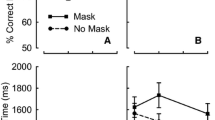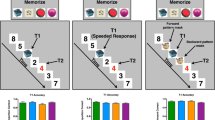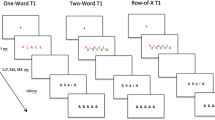Abstract
Identification of the second of two targets is impaired if it is presented less than about 500 ms after the first. Theoretical accounts of this second-target deficit, known as attentional blink (AB), have relied on some form of limited attentional resource that is allocated to the leading target at the expense of the trailing target. Three experiments in the present study reveal a failure of resource-limitation accounts to explain why the AB is absent when the targets consist of a stream of three items belonging to the same category (e.g., letters or digits). The AB is reinstated, however, if an item from a different category is inserted in the target string. This result, and all major results in the AB literature, is explained by the hypothesis that the AB arises from a temporary loss of control over the prevailing attentional set. This lapse in control renders the observer vulnerable to an exogenously-triggered switch in attentional set.





Similar content being viewed by others
References
Allport, A., Styles, E. A., & Hsieh, S. (1994). Shifting intentional set: Exploring the dynamics of tasks. In C. Umiltà & M. Moscovitch (Eds.), Attention and performance XV, (pp. 421–452). Cambridge, MA: MIT/Bradford.
Baddeley, A. (1986). Working memory. Oxford: Oxford University Press.
Barnard, P. J., Scott, S., Taylor, J., May, J., & Knightly, W. (2004). Paying attention to meaning. Psychological Science, 15, 179–186.
Broadbent, D. E. (1958). Perception and communication. Oxford: Pergamon.
Cherry, E. C. (1953). Some experiments on the recognition of speech, with one and with two ears. Journal of the Acoustical Society of America, 25, 975–979.
Chun, M. M. (1997). Temporal binding errors are redistributed in the attentional blink. Perception & Psychophysics, 59, 1191–1199.
Chun, M. M., & Potter, M. C. (1995). A two-stage model for multiple target detection in rapid serial visual presentation. Journal of Experimental Psychology: Human Perception and Performance, 21, 109–127.
Coltheart, M. (1980). Iconic memory and visible persistence. Perception & Psychophysics, 27, 183–228.
Giesbrecht, B. L., & Di Lollo, V. (1998). Beyond the attentional blink: Visual masking by object substitution. Journal of Experimental Psychology: Human Perception and Performance, 24, 1454–1466.
Goldman-Rakic, P. S. (1987). Circuitry of primate prefrontal cortex and regulation of behavior by representational knowledge. In F. Plum & V. B. Mountcastle (Eds.), Handbook of physiology, Section 1, the nervous system, Vol. 5, higher functions of the brain (pp. 373–417). Bethesda, MD: American Physiological Society.
James, W. (1950). The principles of psychology, Vol. 1. New York: Dover. (Original work published in 1890).
Jolicoeur, P., & Dell’Acqua, R. (1998). The demonstration of short-term consolidation. Cognitive Psychology, 36, 138–202.
Kawahara, J., Zuvic, S. M., Enns, J. T., & Di Lollo, V. (2003). Task switching mediates the attentional blink even without backward masking. Perception & Psychophysics, 65, 339–351.
Meiran, N. (1996). Reconfiguration of processing mode prior to task performance. Journal of Experimental Psychology: Learning, Memory, and Cognition, 22, 1423–1442.
Monsell, S. (1996). Control of mental processes. In V. Bruce (Ed.), Unsolved mysteries of the mind: Tutorial essays in cognition (pp. 93–148). Howe, Sussex: Erlbaum (UK) Taylor & Francis.
Pinilla, T., & Valdes-Sosa, M. (in press). Attentional shift time and scene organization: Not all blinks are equal. Psychological Science.
Potter, M. C., Chun, M. M., Banks, B. S., & Muckenhoupt, M. (1998). Two attentional deficits in serial target search: The visual attentional blink and an a modal task-switch deficit. Journal of Experimental Psychology: Learning, Memory, and Cognition, 24, 979–992.
Raymond, J. E. (2003). New objects, not new features, trigger the attentional blink. Psychological Science, 14, 54–59.
Raymond, J. E., Shapiro, K. L., & Arnell, K. M. (1992). Temporary suppression of visual processing in an RSVP task: An attentional blink? Journal of Experimental Psychology: Human Perception and Performance, 18, 849–860.
Rogers, R. D., & Monsell, S. (1995). Costs of a predictable switch between simple cognitive tasks. Journal of Experimental Psychology: General, 124, 207–231.
Shallice, T. (1994). Multiple levels of control processes. In C. Umiltà & M. Moscovitch (Eds.), Attention and performance XV (pp. 395–420). Cambridge, MA: MIT.
Shapiro, K. L., Raymond, J. E., & Arnell, K. M. (1994). Attention to visual pattern information produces the attentional blink in RSVP. Journal of Experimental Psychology: Human Perception and Performance, 20, 357–371.
Shiffrin, R. M., & Schneider, W. (1977). Controlled and automatic human information processing. II. Perceptual learning, automatic attending, and a general theory. Psychological Review, 84, 127–190.
Sperling, G. (1960). The information available in brief visual presentations. Psychological Monographs, 74(11, Whole No. 498).
Treisman, A. (1960). Contextual cues in selective listening. Quarterly Journal of Experimental Psychology, 12, 242–248.
Visser, T. A. W., Bischof, W. F., & Di Lollo, V. (1999). Attentional switching in spatial and non-spatial domains: Evidence from the attentional blink. Psychological Bulletin, 125, 458–469.
Ward, R., Duncan, J., & Shapiro, K. (1996). The slow time-course of visual attention. Cognitive Psychology, 30, 79–109.
Acknowledgements
This work was sponsored by grants from the Natural Sciences and Engineering Research Council of Canada (VDL and JTE), and by the Japan Society for the Promotion of Science (J-iK). We acknowledge the expert assistance of Mark Rempel in the collection and analysis of the data.
Author information
Authors and Affiliations
Corresponding author
Rights and permissions
About this article
Cite this article
Di Lollo, V., Kawahara, Ji., Shahab Ghorashi, S. et al. The attentional blink: Resource depletion or temporary loss of control?. Psychological Research 69, 191–200 (2005). https://doi.org/10.1007/s00426-004-0173-x
Received:
Accepted:
Published:
Issue Date:
DOI: https://doi.org/10.1007/s00426-004-0173-x




